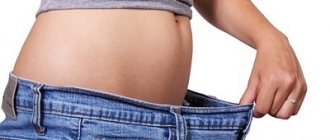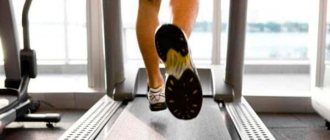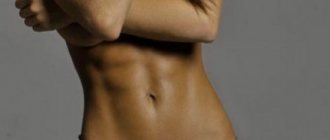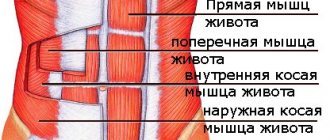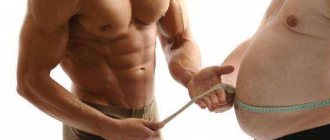What is a press?
There is no such thing as “abs” in anatomy. This is the conventional name for the abdominal muscles. There are four of them: straight, internal oblique, external oblique and transverse.
The rectus abdominis muscle is the largest in area, it is paired and consists of vertical longitudinal muscle bundles. Contrary to the misconception that there are “lower” and “upper” abs, the rectus muscle does not have such a division. The notorious “cubes” stand out due to the tendon jumpers on the rectus abdominis muscle.
The muscle bundles of the external abdominal muscle start from the lower eight ribs and go down radially, the internal oblique muscles are located respectively inside of the external ones. The transverse muscle is located deeper than the other abdominal muscles. In this case, its tendon stretch in the upper two thirds passes behind the rectus muscle, and in the lower third - in front. Partly because of this, the lower “cubes” of the press are less amenable to training than the upper ones.
"Bicycle" - a safe exercise for the spine
One of the important exercises for the press is quite simple and familiar to us from childhood.
Exercise "Bicycle" - an effective way to work all the abdominal muscles
Technique:
- You need to lie on your back so that your buttocks and back are pressed firmly against the surface.
- Raise your legs and make sure there is no arch in your lower back. This is important because it is not safe for the spinal discs; the back tries to reduce the load on the abs, and this reduces the effectiveness of the exercise and injures the spine.
- Hands behind head.
- Next, the exercise can be performed in three versions: classic, easy and complex.
- The classic method is as follows: arms folded behind the head, both legs bent at the knees and pulled towards the stomach. After a deep inhalation, exhale, extending your right leg without touching the floor, and turning your body slightly to the left, try to touch your right elbow to your left knee. You need to exhale at every step, this increases the effectiveness of the exercises
- Returning to the starting position, you inhale and repeat on the other side.
- This method will work both the oblique and rectus muscles. But if it's hard, you can make it easier and do an easier version.
- To do this, place your hands along the body (or put them behind your head), pull your legs up and inhale and exhale straighten the first leg, return it, then stretch out the other. Without rotation, the lateral muscles are not actively engaged, but are still partially active
- Due to the fact that there is no rotation, the work of the oblique muscles is much less. However, you will perk up a little, which will increase the tension in your muscles.
- Also, this exercise can be difficult if you pick up dumbbells, weights, a ball, or something else.
Why do we need abs?
The abdominal muscles belong to the so-called core muscles, a complex of muscles responsible for stabilizing the spine, pelvis and hips. Each of the abdominal muscles is responsible for its own functions. The rectus muscle is for twisting the body in the lumbar region, the external oblique muscle is for rotating the body in the opposite direction, flexing the spinal column, and is involved in the contraction and expansion of the chest. The internal oblique muscle is responsible for the same functions as the external oblique, but is responsible for rotating the body in the other direction. The abdominal muscles, together with the muscles of the lumbar back, allow you to maintain posture, participate in the respiratory process, and in women they play an important role during childbirth.
The influence of a sculpted belly on male potency
First of all, it is necessary to achieve strength in the muscles located in the back, abdomen, buttocks and legs. This helps strengthen the core and also has a positive effect on blood flow.
Potency in men consists of two factors – “I want” and “I can”. The latter is expressed in the ability to achieve a strong and long-lasting erection. In order for the penis to be in a stable erect state, it is important that it is supplied with the necessary amount of blood.
For this you need:
- A healthy heart that ensures normal blood flow;
- Elastic vessels with strong walls through which blood passes;
- High patency of the arteries located in the penis.
Thus, a well-pumped press affects potency, ensuring a normal level of blood supply to the penis. Sports activities also stimulate the production of testosterone, the main sex hormone responsible for the ability to experience arousal.
During sexual intercourse, some poses involve active use of the abdominal muscles. With weak muscles, after the end of intimacy, pain appears in the abdominal area. Moreover, there may simply be a lack of physical endurance and preparation, which is why you have to change position. There may even be a decrease in the level of erection due to severe tension.
It is important not to overdo it in sports. Excessive effort has a negative impact on the body systems located in the abdominal cavity and can provoke diseases of the reproductive and urinary systems.
The bigger, the better?
One of the most common misconceptions about abdominal training is that the more reps we do in a set, the stronger and more voluminous our abs will be. In fact, the abdominal muscles are no different in terms of training, for example, from the biceps. To increase your biceps, you will begin to do one hundred repetitions per approach; on the contrary, you will reduce the number of sets and repetitions, but increase the load. By increasing the number of repetitions per set, you will develop strength endurance, but this will not make the muscle thicker. It is much more effective to increase the load, do sets with weights and reduce the number of repetitions per set from 8 to 20.
The more often the better?
Recovery is no less important part of the training process than the loading phase. After training, muscles go through three stages: recovery, supercompensation and return to performance. In order for muscles to grow, you need to draw up a training plan in such a way that the next workout falls on the supercompensation stage, but in no case during the recovery period. These processes were described back in 1953 by B.S. Gipenreiter in the book “Recovery processes during sports activity.” The abdominal muscles, like any other muscles, need time to recover. Otherwise, not only can training be wasted, but the risk of injury will also increase. Do you need it?
Why don't you need to pump up your abs?
So, are you into fitness and want to have a flat or toned stomach? Let's figure out why for these purposes you don't need to pump up your abs, as we are used to doing.
Abdominal training does not burn belly fat
In order to see the desired cubes, you need to burn the fat layer on your stomach. When you do abs, you strengthen muscles, but don't burn fat. The muscles will become toned from the load, but this will not make your stomach flat, because you are not working on eliminating the fat layer . And if you don’t have belly fat, then even two or three abdominal workouts are usually enough for the muscles to become toned and the abs to appear accordingly.
At the same time, abdominal training burns so few calories that even doing abdominal exercises all day , you will hardly burn at least 300 kcal. For example, you can burn the same amount of calories in half an hour of intense cardio training, but in addition you will also speed up your metabolism. Abdominal training does not affect our metabolism, unlike aerobic exercise and most other strength exercises.
Indirect exercises are usually enough to pump up your abs
The abdominal muscles are very responsive and do not require special exercises to strengthen and tone them. They come into play even if you use them indirectly when training other muscle groups . Any exercise in which you tense your abdominal muscles is suitable, for example: squats, lunges, deadlifts, bent-over rows, deadlifts, etc.
If you do strength training, then this is enough to pump up your abdominal muscles. They are perfectly strengthened due to indirect load, so various crunches and bicycles are not at all necessary. Many trainers include them in their programs out of habit and because they are in demand among the audience.
There are no methods for local fat burning
If you want to find a magical way to burn belly fat locally, forget about it. It simply doesn't exist. Hoops, crunches, massages will not help you burn belly fat, which means they have no practical use. We have already written about local weight loss, but it wouldn’t hurt to repeat it. The whole body loses weight evenly and entirely; it is simply impossible to remove fat from the abdomen only .
Moreover, weight loss occurs when you burn more calories than you consume. Focus on eating right and working out your entire body if you want to get toned abs. By the way, you can achieve a flat stomach even without training if you eat in a calorie deficit .
Instead of abdominal exercises, it is more effective to perform other strength exercises or cardio training
When you pump up your abs, you burn virtually no calories. Various crunches, leg lifts, bicycles - these are some of the lowest-cost exercises that use the body's resources to a minimum. Abdominal training does not in any way affect a person’s metabolism and the development of other muscle groups.
Therefore, you shouldn’t waste time pumping up your abs—it’s better to do other strength or cardio workouts. Thus, by training all other muscle groups or doing cardio, you will get a flat stomach faster than if you just pump up your abs. The abdominal muscles are important as a spinal stabilizer, but in this case it will be more effective to perform isometric exercises for the core muscles.
Twisting on the floor can injure your back and lower back
Of course, any exercise can lead to injury if the correct technique is not followed. But when the question arises about the advisability of exercises in general, there is reason to think: is it necessary to take risks ? Although twisting and its modifications seem to be the simplest and most understandable exercises, very often practitioners get injured in the neck, back and lower back precisely when pumping the abs
The fact is that when doing crunches, it is very important to follow the technique and put the load on the abs, and not on the back. With the slightest disturbance or even loss of concentration, you can get an unpleasant injury. In exercises for other muscle groups, it makes sense to hone the technique, because their benefits are not in doubt . But whether there is a serious need for twisting is up to you to decide.
Technology first
The abdominal muscles work in tandem with the hip flexors. In addition, the muscles of the lumbar back are involved in body lifts, the so-called crunches. Under no circumstances should you make sudden movements when performing crunches, as this can lead to injury. The optimal exercise for the rectus abdominis muscle is crunches on the so-called abdominal bench: this machine allows you to stretch the muscle, which makes the workout more effective, as the range of motion increases.
Combine exercises
It is unlikely that you will be able to pump up a beautiful abs with the help of just bending the body on the floor or on an abdominal bench. Experts advise combining exercises. The optimal workout for getting a six-pack may include, for example, low-range isolated crunches, abdominal crunches, or hanging or incline leg or knee raises. To train the oblique abdominal muscles, crunches from a lying position, which can be done with weights, will also be effective.



